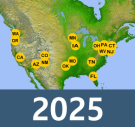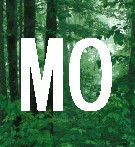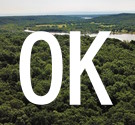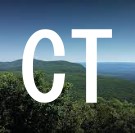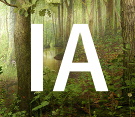Geographical Index > United States > West Virginia > Pocahontas County > Report # 11432
(Class B)
Submitted by witness on Sunday, April 24, 2005.
Possible sighting during BFRO's West Virginia expedition, Spring 2005
(Show Printer-friendly Version)
YEAR: 2005
SEASON: Spring MONTH: April DATE: 13 STATE: West Virginia COUNTY: Pocahontas County OBSERVED: My husband and I attended the BFRO expedition in West Virginia in Spring of 2005. The base camp was next to a river in the mountains near the Virginia border.
On Thursday afternoon most of the people crossed the river by canoe in order to hike down the trail along the opposite bank of the river. After that group set off, Steve, my husband, headed out in his truck with a big handheld radio to see if he could reach the others who had walked down the river trail. I was alone in the base camp.
After about a half hour I went outside and stood at the nose of the camper and looked up the road to see if Steve had driven away, then I turned around to go to the river. I looked through the trees and saw what I first thought were two people from the river group coming back up the trail, around the bend in the river trail. I walked straight over to the river's edge to get ready to take pictures of them crossing back over in the canoe.
When I got to the riverbank I looked across and saw no one, which was surprising. There was no place to hide along the river trail for the next 200 yards. One side of the trail was the riverbank. The other side was the jagged rock face of the river canyon. From the ground upward, the rock face was mostly bare for about the first 15 feet. Then there was thick mountain laurel the rest of the way up, covering the rock outcroppings and ledges.
You could not get out of view unless you were to climb up into the mountain laurel above the trail. It was a near vertical climb, but there was no other way they could have vanished so quickly in any other direction.
Then I started thinking about the figures I saw. They had looked pretty slender, but it was a cold day. Everyone was bundled up for cold and rain and looked a bit “plump”. The figures I saw seemed lanky with a lazy walk. They were also walking into the sunlight when they came around the bend, but I didn't see any color – no clothes, no light skin, no sneakers, no hats, etc. They were tree-trunk dark. The taller one was walking closest to the hillside; the shorter one was closer to the river.
Steve returned to the camp and I asked him to radio to the group that walked down the river. They had walked past that same bend and would have noticed anyone walking up the trail in the opposite direction.
The river group responded and said no one passed them in the oppositive direction. They said anything coming around that bend must have come down from the side of the canyon, then climbed back up the canyon wall. They offered to walk back to that point to provide some scale, for me to compare the height. They asked me to return to where I had been standing when I saw the figures.
I went back to the same spot. The river group radioed that they were coming around the bend in the trail. They said to look over at them as they came into view. When I did it immediately struck me that they appeared much smaller than the figures I saw.
There were other things about their appearance that sharply contrasted with the figures I saw. I could see the gaps of air between their arms and torso -- unlike the humans who were so bundled up with rain gear that you could not see any gaps betwen their arms and torsos.
Several other things happend along this same river during the expedition. I'll let the other people who were present on the expedition describe those occurrences.
OTHER WITNESSES: None - was alone at the base camp. I do not think I was seen by the creatures since they moved in such a relaxed manner. OTHER STORIES: There were other incidents on the two expeditions in West Virginia. Mine was the only visual incident, as far as I know. TIME AND CONDITIONS: 3:30-4 p.m. - a cold, drizzly day turned into sunny ENVIRONMENT: West Virginia mountains in early spring.
Follow-up investigation report by BFRO Investigator Bill Scott:
I arrived at the base camp right after the event and spoke to the witness.
At the time of the sighting, the other expedition members were out of sight, further down the trail. The other members reported that they did not pass anyone along the trail.
The two figures were viewed in the mid-afternoon from about 200 yards away. When the witness reached the riverside and looked again, they were gone. The only way to avoid being seen would have been to scramble up the steep hillside on the left or dive into the freezing river and swim away underwater.
The witness stated that there wasn't likely enough time for the bipeds to turn the opposite direction and go back behind the bend on the trail.
The witness' estimate of height came from observing other members of the group in the same spot on the trail. She emphasized that people looked very short and round compared to the figures she saw. She described seeing "more space between the arms and legs" on the figures.
No tracks could be seen on the trail as it is hard packed gravel. A couple of days later in the early morning, I was walking the trail with another expedition member when he spotted a freshly broken mountain laurel limb about twenty feet up the steep slope near where the bipeds were spotted. The limb was about 1 1/2 inches in diameter. The slope was too treacherous for us to climb because of the loose shale and the steep grade. We discussed the fact that the limb was too thick for a small animal to break and it was unlikely that an animal such as a deer or bear would be able to make its way in that direction. There were no signs of something falling and breaking the limb.
This mountainous part of Pocahontas County has a history of sightings. Some of the residents we talked to reported strange howls near the river at night. One expedition member also spoke to a local who said she would not return to the area where we were camped because her family had had rocks thrown at their tent at night, but there was no one else camping in the area.
About BFRO Investigator Bill Scott:
Bill Scott works as a small business manager near Washington, DC. He has extensive knowledge of the State and National parks in the Mid-Atlantic area.
Bill has participated in the following expeditions: Washington (Oly Pen -1), West Virginia.
|

